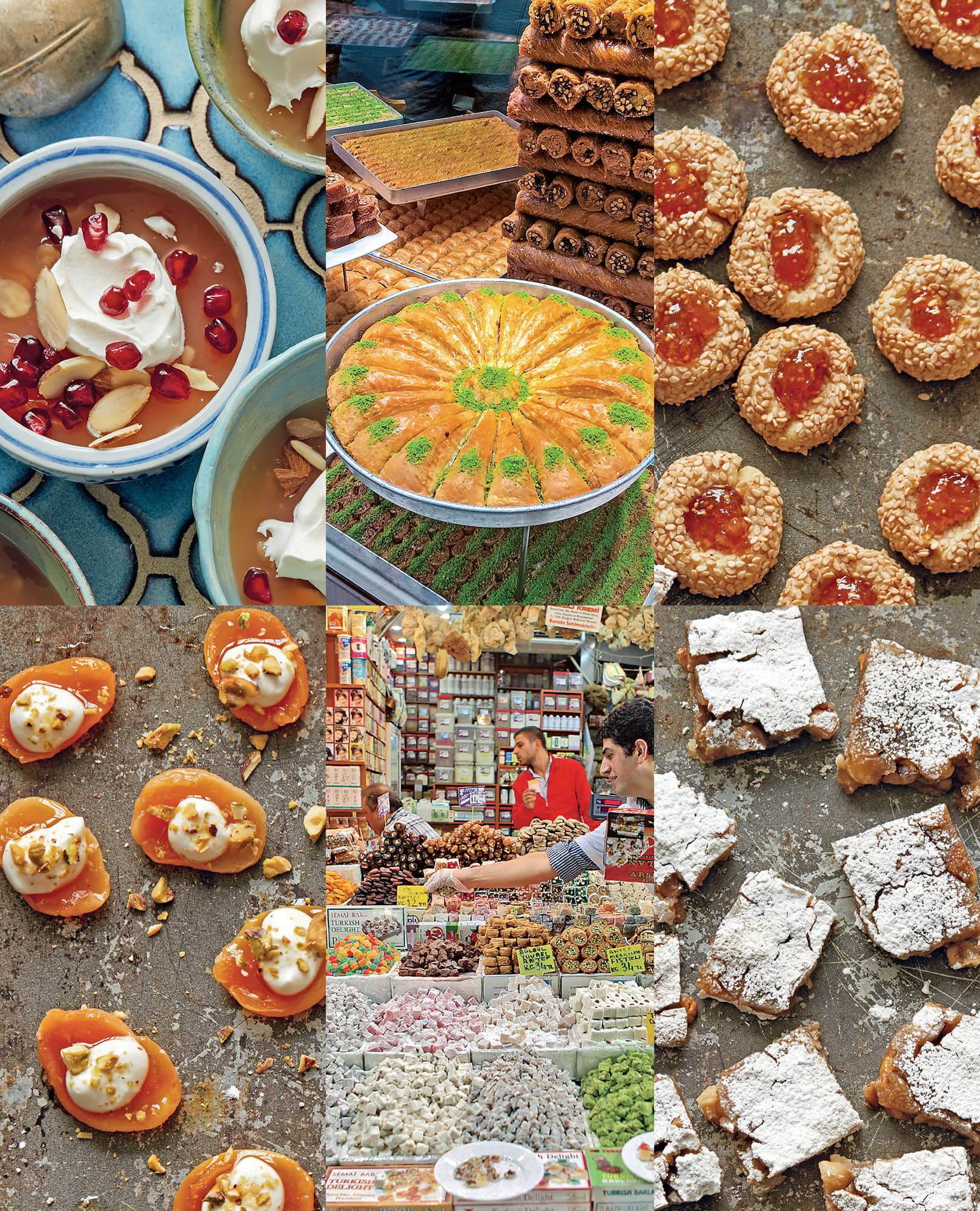
Sweets and Traditions
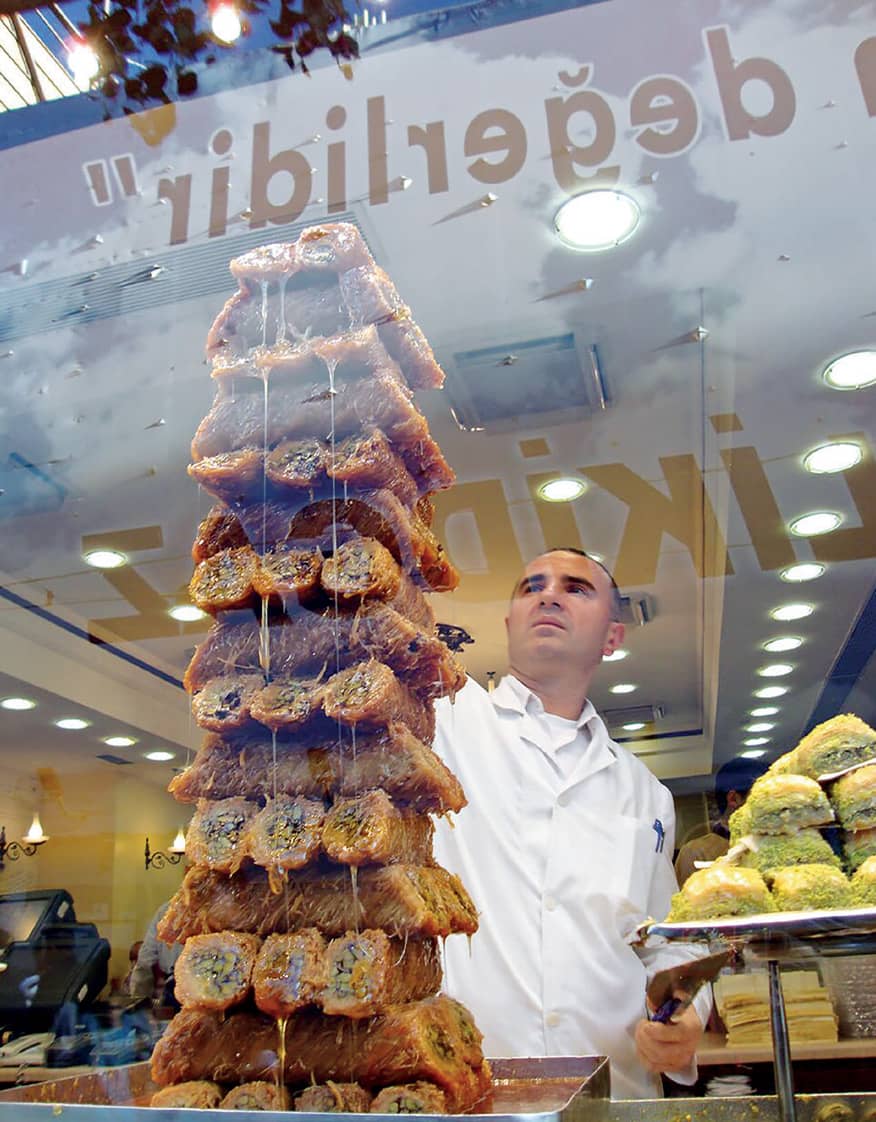
A tower of sweets tempts on Istiklal Avenue in Istanbul’s Taksim district
Most first-time visitors to Turkey are already familiar with two famous desserts: jewel-like squares of Turkish delight, or lokum, and flaky, nut-filled baklava. Both delicious treats can be purchased fresh from cases at confectioneries or baklava shops, where they come packed in pretty boxes and make wonderful gifts. Tradition says that when the family of a prospective groom brings the gift of Turkish delight to the potential bride’s family, a sweet conversation will follow.
Sweets are usually eaten in the late afternoon as a social break in the day, with a cup of tea or a demitasse of dark Turkish coffee. Our friend Mahomet has been serving warm pistachio baklava in the afternoon for thirty years in his Konya baklavaci (baklava shop), like his father and grandfather before him. His profession is as honored today as it was a hundred years ago.
Muhallebi, or pudding, is a favorite dessert. In the Turkish kitchen, pudding is a traditional and beloved dish that lends itself to creative expression, as when it is spread atop caramel and rolled into a sumptuous roulade. Creamy baked rice pudding, with its golden brown skin, remains a comfort-food classic for many—us included.
And then there’s rose milk pudding, fragrant pale pink and streaked with the occasional shred of petal. For five thousand years, roses have been cultivated and used as medicine, food and perfume in the Middle East, Persia and Turkey. The Greeks and Romans considered public gardens planted with fragrant Rosa damascena to be as important as grain. Today, Turkey is one of the leading producers of rose oil and rosewater. In Isparta, during harvest time, fields of pink roses transform the city with their scent.
Throughout Turkey, fruit—cherries served over ice in an elegant bowl, white peaches served whole, tart apple slices with honey or dried apricots stuffed with yogurt or thick cream—is preferred after an evening meal.
Sesame Thumbprint Cookies with Fig Jam
MAKES 36 COOKIES
Buttery thumbprint cookies, with their nut-studded exteriors and delicious jam centers, have been a part of our baking vocabulary since childhood. Here, we’ve introduced the flavors of the Levant—orange in the dough, sesame seeds for coating and a luscious fig jam filling—for a worldly take on a classic American cookie. Serve these as part of a dessert tray with Turkish delight and coffee, or as a sweet addition to breakfast.
1 cup (450 g / 2 sticks) butter
1/2 cup (110 g) packed light brown sugar
2 large eggs
1/2 teaspoon pure vanilla extract
1 tablespoon orange zest
21/2 cups (315 g) all-purpose flour
1/2 teaspoon kosher salt
1 cup (150 g) sesame seeds
1/3 cup (103 g) fig jam
Heat the oven to 350°F (175°C) and line 2 baking sheets with parchment.
In a medium mixing bowl, cream together the butter and brown sugar until light and fluffy, 2 to 3 minutes.
Separate the egg yolks from the whites, and set the egg whites aside. Add the yolks to the butter mixture 1 at a time, mixing well after each addition. Stir in the vanilla and the orange zest.
In a separate bowl, sift together the flour and salt. Combine the wet and dry ingredients and stir to create a firm dough.
In a small bowl, lightly beat the egg whites until frothy. Pour the sesame seeds onto a small plate and set it next to the bowl of egg whites.
To make the cookies, shape 2 teaspoons of dough into a ball. Roll it in the egg whites and then in the sesame seeds and set on the prepared baking sheet. Repeat with the remaining dough, placing the cookies about 1 inch (25 mm)apart.
With your thumb, make an indentation in each cookie. Lightly fill the indentation with 1/4 to 1/2 teaspoon fig jam. Do not overfill.
Bake for 15 to 20 minutes, until the cookies are a delicate golden brown and slightly puffy. If the cookies begin browning too fast, lay a piece of parchment over the top for the last 5 minutes of baking.
Store the cookies in a tightly sealed container for 3 days, in the refrigerator for 1 week or in the freezer up to 1 month.


◁ Stuffed Apricots (Gün Kurusu)
SERVES 6
While rich sweets such as baklavas and puddings are usually enjoyed in the late afternoon with a cup of tea or coffee, Turks prefer fresh ripe fruit after the evening meal. The most prized apricots are those grown in the Malatya province, in rich alluvial soil from the Euphrates. Serving them with thick yogurt and local honey is typically Turkish. Add a sprinkling of ground, toasted nuts and serve for dessert or breakfast.
6 fresh apricots, peeled, pitted and cut in half, or 6 best-quality dried apricots
1/4 to 1/2 cup (60 to 120 ml) Greek yogurt
2 tablespoons honey
2 tablespoons ground walnuts, pistachios or hazelnuts
If using dried apricots, place them in bowl and cover with hot water. Soak for 20 minutes. Drain and pat dry on a paper towel.
Cut the apricots in half and lay them, cut side up, on a serving plate.
Stir the yogurt until smooth, and place a heaping 1/2 teaspoon on top of each apricot half. Drizzle the honey over the yogurt. Sprinkle with the ground nuts.

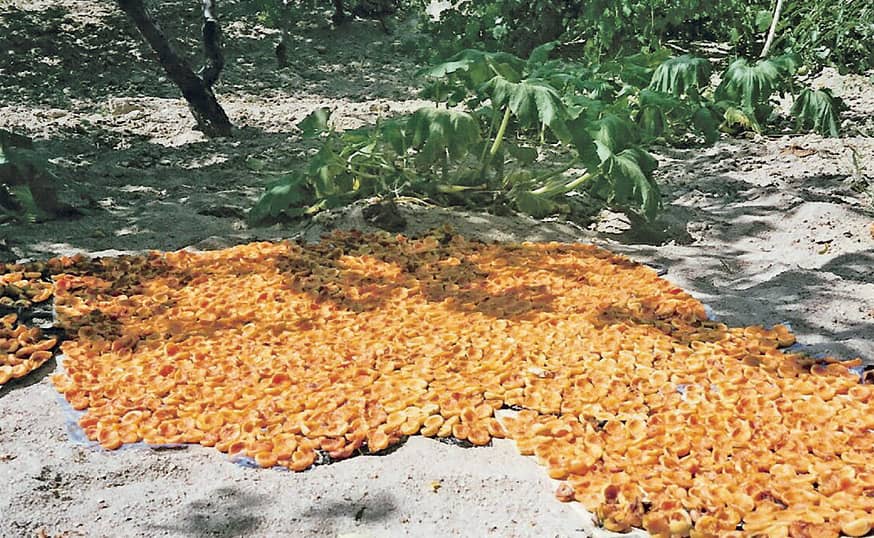
Delicate ripe apricots, just harvested in an orchard in Cappadocia
Black Sea Hazelnut Baklava
MAKES ABOUT 30 (11/2-inch / 38 mm) PIECES
If you try tracing the origins of baklava, you will surely get lost, not only in time, but in place as well. Nearly every culture from Central Asia to Europe has a recipe for thin dough layered with sweetened nuts.
Turkey is the largest supplier of hazelnuts, producing 80 percent of the world’s supply. And while nuts feature prominently in many Turkish dishes, hazelnuts reign supreme, lending their rich flavor to all manner of foods, especially sweets. An equal weight of unsalted shelled pistachios may be substituted for the hazelnuts. Today, Gaziantep, in the pistachio-growing region of southeastern Turkey, is famous for its crisp, not-too-sweet baklava.
To impress your guests, bake the baklava while having lunch or dinner. Remove it from the oven, and just before serving, bring the pan to the table. Pour the cool syrup over the hot pastry and listen to it sizzle as it releases a sweet, nutty aroma.
3/4 pound (340 g) hazelnuts
1/4 cup sugar
1 cup (450 g / 2 sticks) butter
1/2 pound (227 g) filo dough
1 teaspoon lemon juice
Heat the oven to 275°F (135°C). Put the nuts in a single layer on a baking sheet and roast them in the oven for 15 to 30 minutes or until the skins crack and the nuts turn a light golden color.
Remove the nuts from the oven and put them in a clean kitchen towel. Let them cool for 10 minutes then rub vigorously in the towel to remove as much skin as possible.
Increase the oven temperature to 350°F (175°C). Put the roasted nuts in a food processor and pulse into a medium-fine grind, being careful not to process into a paste. Add 1/4 cup of the sugar and pulse to blend. Reserve 1 tablespoon of the hazelnut-sugar mixture for finishing the baklava.
Melt the butter in a small saucepan. Using a pastry brush, coat the bottom of a 9 by 13-inch (23 by 33-cm) baking dish with a layer of butter. Place a sheet of filo dough over the butter. Brush another layer of butter over the filo and repeat until half of the filo sheets have been layered with butter. Brush the top piece of filo with butter. Keep the remaining dough covered with a damp kitchen towel to prevent it from drying out.
Sprinkle the hazelnut mixture evenly over the filo, pressing down gently to create an even surface. Continue to layer the remaining filo and butter over the nuts until all the filo sheets have been used. End with a final brushing of butter. Press down again gently on the surface of the pastry.
With a sharp knife, cut through the pastry on the diagonal beginning in 1corner of the pan and cutting every 11/2 to 2 inches (38 to 50 mm). Turn the pan around and make opposing cuts to create about 30 diamond-shaped pieces. (The baklava may be assembled up to a day in advance at this point, then covered tightly and refrigerated. Return to room temperature before baking.)
Put the baklava on the middle rack of the oven and bake for 15 to 20 minutes. Reduce the temperature to 300°F (149°C) and bake for 15 to 25 minutes more. The baklava should be lightly browned and crisp.
Meanwhile, make the syrup. Combine the remaining 1 cup (200 g) of sugar and 3/4 cup (177 ml) water in a small pan over medium heat. When the syrup reaches a boil, reduce the heat and simmer for 5 minutes. Add the lemon juice and simmer for about 5 minutes more. Remove from the heat and cool to room temperature.
Remove the baklava from the oven and immediately pour the syrup evenly over the top, letting it sizzle and soak into the pastry. To finish, sprinkle the tablespoon of reserved hazelnut-sugar mixture over the pastry. Let the baklava rest for about 1 hour, and cut again to loosen each piece.
Serve the baklava at room temperature with Turkish coffee, mint tea and small glasses of water.

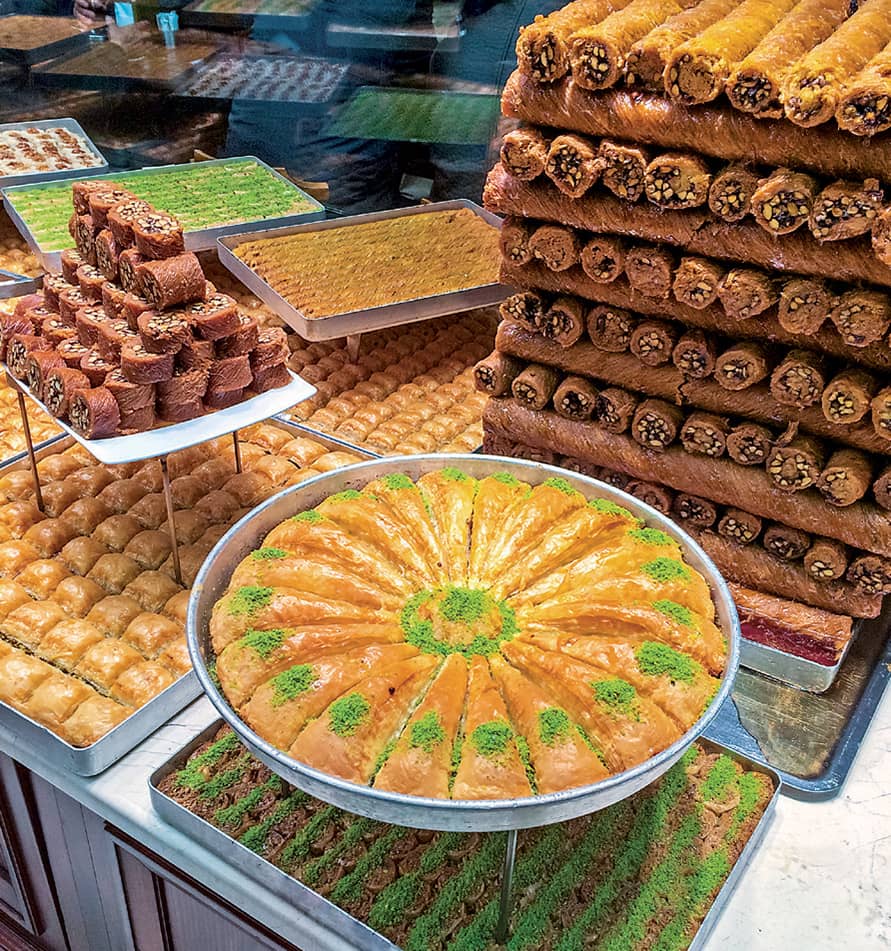
Pistachio baklava beckons from a shop window in the southeastern city of Gazientep.
Caramel Milk Pudding Roulade (Kazandibi)
SERVES 6 TO 8
Along with Turkish Delight, Kazandibi ve Tavuk Göğsü, a rolled milk pudding with finely shredded chicken breast and a caramelized sugar crust, is a famous sweet to emerge from the kitchens of Ottoman court. You will find trays of kazandibi in the windows of every sweet shop, particularly in Istanbul. The concept of adding chicken to a sweet dessert is foreign to our tastes, so with the help of a friend, we’ve created this elegant version, which omits the chicken. It’s another festive dessert that just happens to be gluten-free.
FOR THE CARAMEL
1 tablespoon butter, softened
1/2 cup (65 g) confectioner’s sugar
FOR THE PUDDING
1/2 cup (65 g) cornstarch
1/2 cup (60 g) rice flour
11/2 cups (354 ml) cold water
43/4 cups (11 dL) milk
1 cup (200 g) sugar
1 teaspoon pure vanilla extract
1 cup (130 g) finely ground unsalted pistachios
1 tablespoon cinnamon
FOR THE WHIPPED CREAM
1 cup (236 ml) heavy cream
1 teaspoon sugar
1/4 teaspoon pure vanilla extract
1 pint (250 g) raspberries
MAKE THE CARAMEL LAYER: Lightly coat a 9 by 13-inch (23 by 33-cm) baking dish or quarter sheet pan with the butter. With a sieve, evenly sprinkle the confectioner's sugar over the butter. Turn a burner on the stove to medium-high. Wearing oven mitts and starting at the upper left hand corner of the pan, place it on the burner. Allow the butter and sugar to melt and bubble for about 30 seconds. Carefully continue rotating the pan until all the sugar has melted and the mixture turns deep golden brown. Make sure the caramel is evenly distributed over the bottom of the pan. Set aside.
MAKE THE PUDDING: In a small bowl, combine the cornstarch and the rice flour. Whisk in the cold water until the mixture is smooth. Set aside.
In a medium heavy saucepan over medium-high heat, combine the milk, sugar and vanilla, stirring to dissolve the sugar. As soon as the mixture comes to a boil, reduce the heat to medium.
Give the cornstarch-rice flour mixture a quick whisk and add it in a slow, steady stream to the milk mixture. Stir constantly for 3 to 4 minutes until the pudding becomes thick enough to spread. Remove from the heat.
Immediately spoon the warm pudding over the caramel, beginning in the center of the pan. Using an offset spatula, spread the pudding evenly outward over the caramel to the edges of the pan. Cool the pudding on a rack for about 1 hour. Refrigerate for 1 to 2 hours until firm, and up to 24 hours.
FINISH THE ROULADE: Sprinkle the pistachios evenly over the pudding. Gently lift the pudding along the long end of the pan and roll it over the pistachios. Keep rolling the pudding until it reaches the opposite end. Slide the roulade gently to the center of the pan. Spoon any leftover caramel over the roulade. With a fine-mesh sieve, sift the cinnamon over the roulade.
Make the whipped cream: Just before serving, pour the cream into a chilled bowl. With a wire whisk or electric hand mixer, whip the cream until it begins to thicken. Add the sugar and vanilla and whisk until soft peaks form.
Cut the roulade into 11/2-inch (38-mm) pieces. Place 1 or 2 pieces on each serving plate, garnish with the raspberries and top with whipped cream.

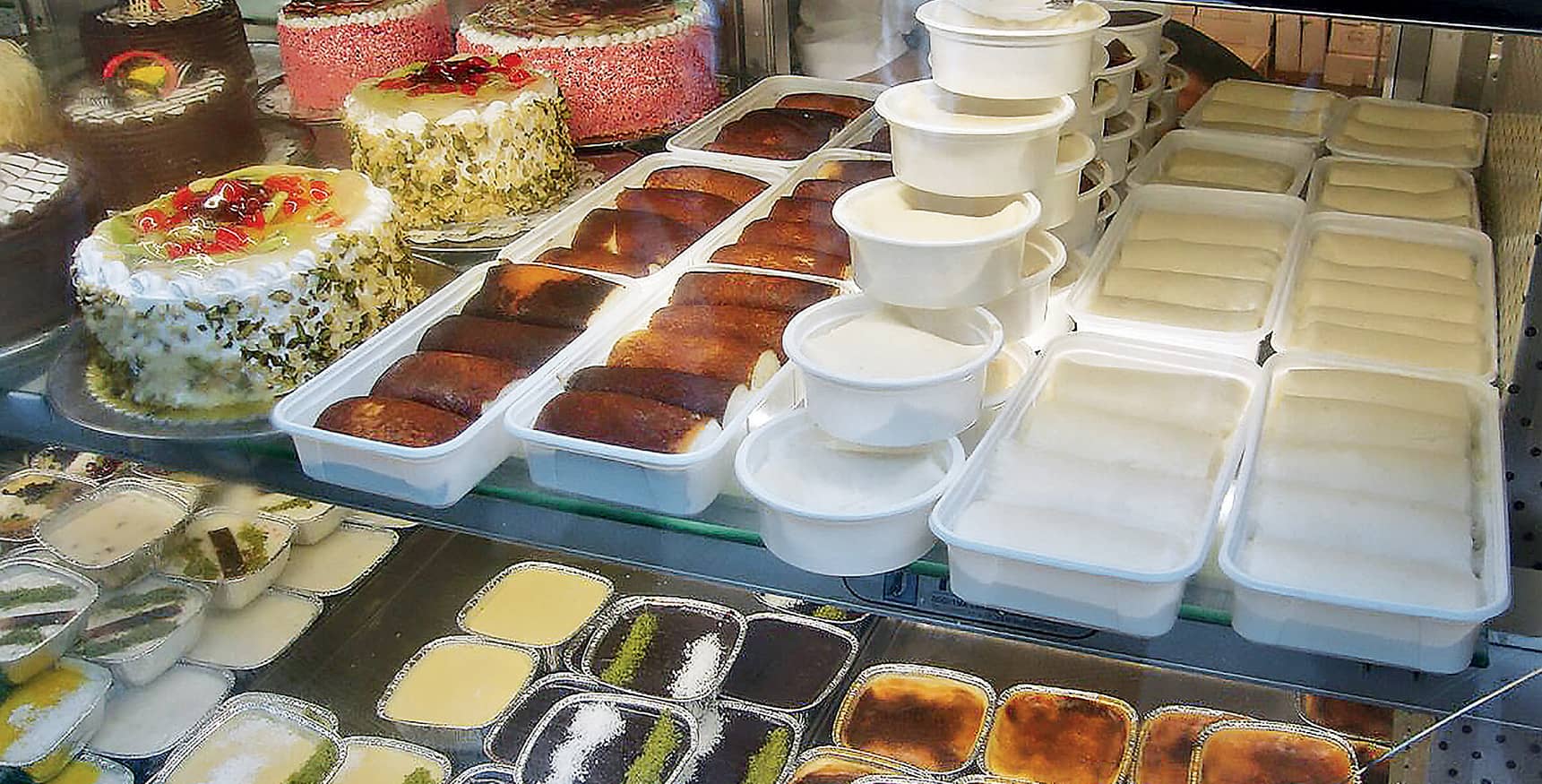
An array of milk-based desserts at a pudding shop on Divanyolu in Sultanahmet
Lale Pudding Shop Baked Rice Pudding (Fırın Sütlaç)
SERVES 6
The Lale (tulip) Restaurant, better known as the Pudding Shop, became famous in the 1960s and 1970s as a meeting place for young people heading overland to India and Asia on what was known as the “hippie trail.” In 1978 it was featured in the film Midnight Express. On a bulletin board set up by the owners, backpackers left notes for one another and waited for friends to arrive from far-flung locations, sitting in booths or in the garden eating inexpensive, filling rice pudding. Whenever we travel to Istanbul, we make a pilgrimage to the Pudding Shop for this ultimate comfort food. With its golden crust and creamy interior, it will please any child or adult.
1/4 cup (30 g) cornstarch
43/4 cups (11 dL) milk, divided
1/2 cup (100 g) short-grain white rice
1/2 cup (100 g) suger 1 teaspoon pure vanilla extract
Heat the oven to 400°F (204°C). Put the cornstarch in a small bowl and add 1/4 cup (60 ml) of the milk. Stir to create a slurry and set aside.
In a large saucepan combine the rice and enough water to cover by 1/2 inch (13 mm). Bring to a boil over medium heat. Reduce the heat and simmer for 5 minutes or until all the water has been absorbed.
Stir the remaining 41/2 cups (11 dL) milk and the sugar into the rice. Set over medium-high heat and stir to dissolve the sugar. Bring to a boil, then reduce the heat and simmer for 20 minutes, stirring occasionally to prevent it from sticking to the bottom of the pan. The pudding will begin to thicken.
Remove 1/2 cup (120 ml) of the hot pudding and stir it into the cornstarch slurry. Pour the mixture back into the pot in a slow steady stream, stirring constantly. Add the vanilla and return the pudding to a low simmer. Cook without stirring for 2 minutes. The pudding will be thick.
Using a ladle, spoon the pudding into a 11/2 quart (14 dL) baking dish or divide among individual 1-cup (236-ml) ramekins. Set in a baking pan with high sides and pour water 1/2 inch (13 mm) up the side of the baking dish or ramekins before sliding the pan into the oven.
Bake for 30 to 35 minutes, until a deep brown skin forms on the top of the pudding. Remove from the oven, cool to room temperature and serve, or refrigerate the cooled pudding, covered, for up to 8 hours before serving.

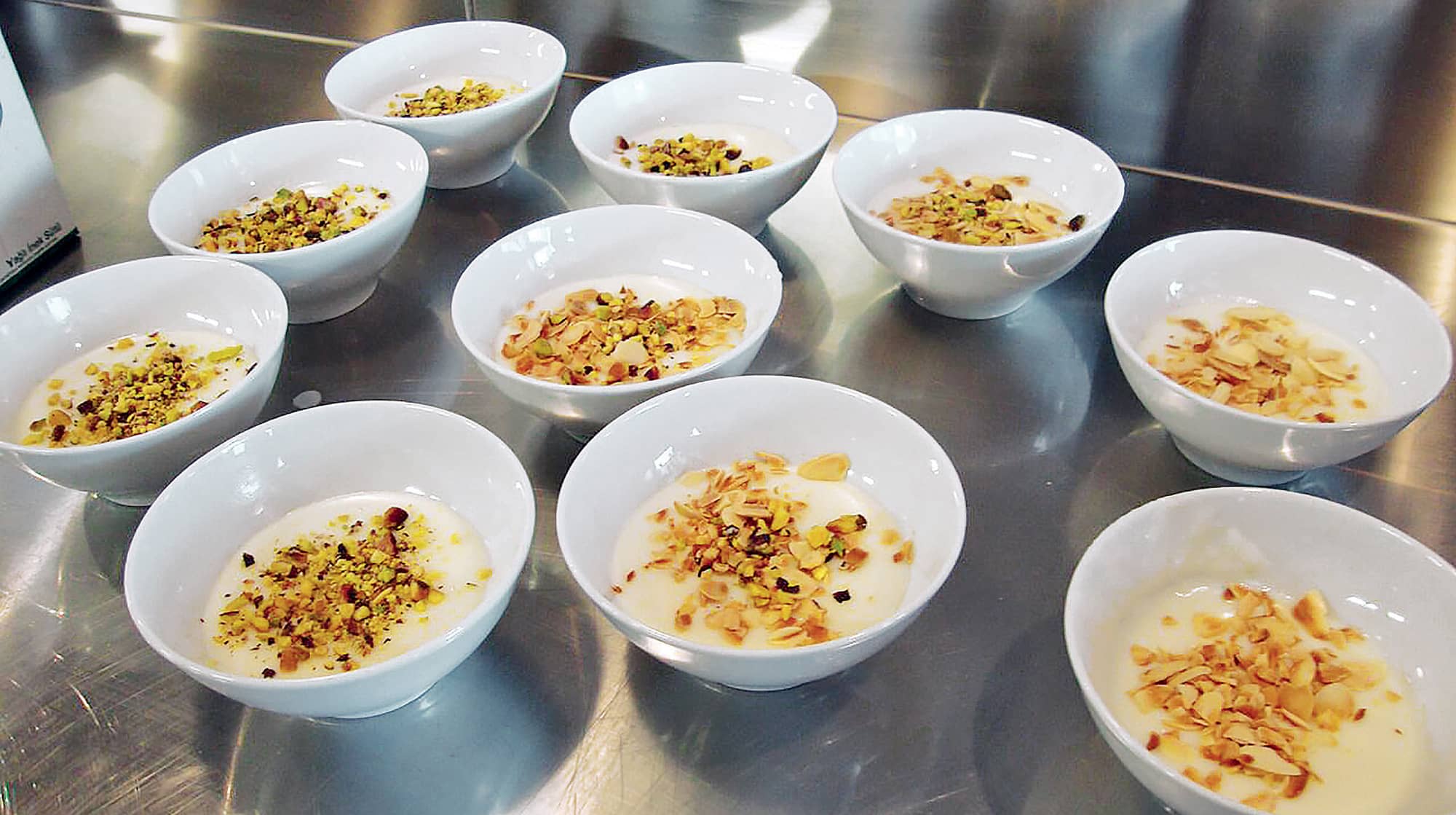
Warm, creamy milk pudding with pistachios is traditional Turkish comfort food.
Rose Milk Pudding
SERVES 4 TO 6
In Anatolia, Persia and the Middle East, Rosa damascena, the legendary Damascus rose, lends its fragrance to many dishes, including this elegant pudding. We first tasted it on a summer night in Istanbul on the balcony of Tugra Restaurant at the Çırağan Palace. A full moon was rising over the Bosporus when a waiter arrived with silver domed plates and set them before us. With a flourish, he removed the domes to reveal stemmed crystal glasses containing creamy custard garnished with deep red rose petals. We swooned at first bite and rushed to buy bottles of rosewater at the spice bazaar so we could recreate the pudding at home. These days we can easily find it in specialty shops, and this pudding has become a favorite among family and friends.
1/2 cup (150 g) sugar
1/4 cup (40 g) rice flour
1/8 teaspoon kosher salt
3 cups (7 dL) milk
2 teaspoons rosewater
8 red or deep pink organic rose petals, plus more for garnish (optional)
1/4 cup (30 g) toasted finely chopped pistachios
In a small bowl, combine the sugar, flour and salt.
In a medium heavy saucepan over moderate heat, combine the milk and the rosewater. Add the 8 rose petals, if using, along with the sugar mixture and whisk to combine.
Bring the pudding to a boil. Reduce the heat to simmer and cook, stirring constantly, until the mixture thickens and coats the spoon. This will take about 20 to 25 minutes. The rose petals will give up their color and should dissolve into the pudding. If desired, it can be strained before serving to remove any stray bits of flower petal.
Divide the pudding among serving bowls. Serve at room temperature, or let cool, cover and refrigerate for 1 hour or overnight. Before serving, garnish with the chopped pistachios and a reserved rose petal.

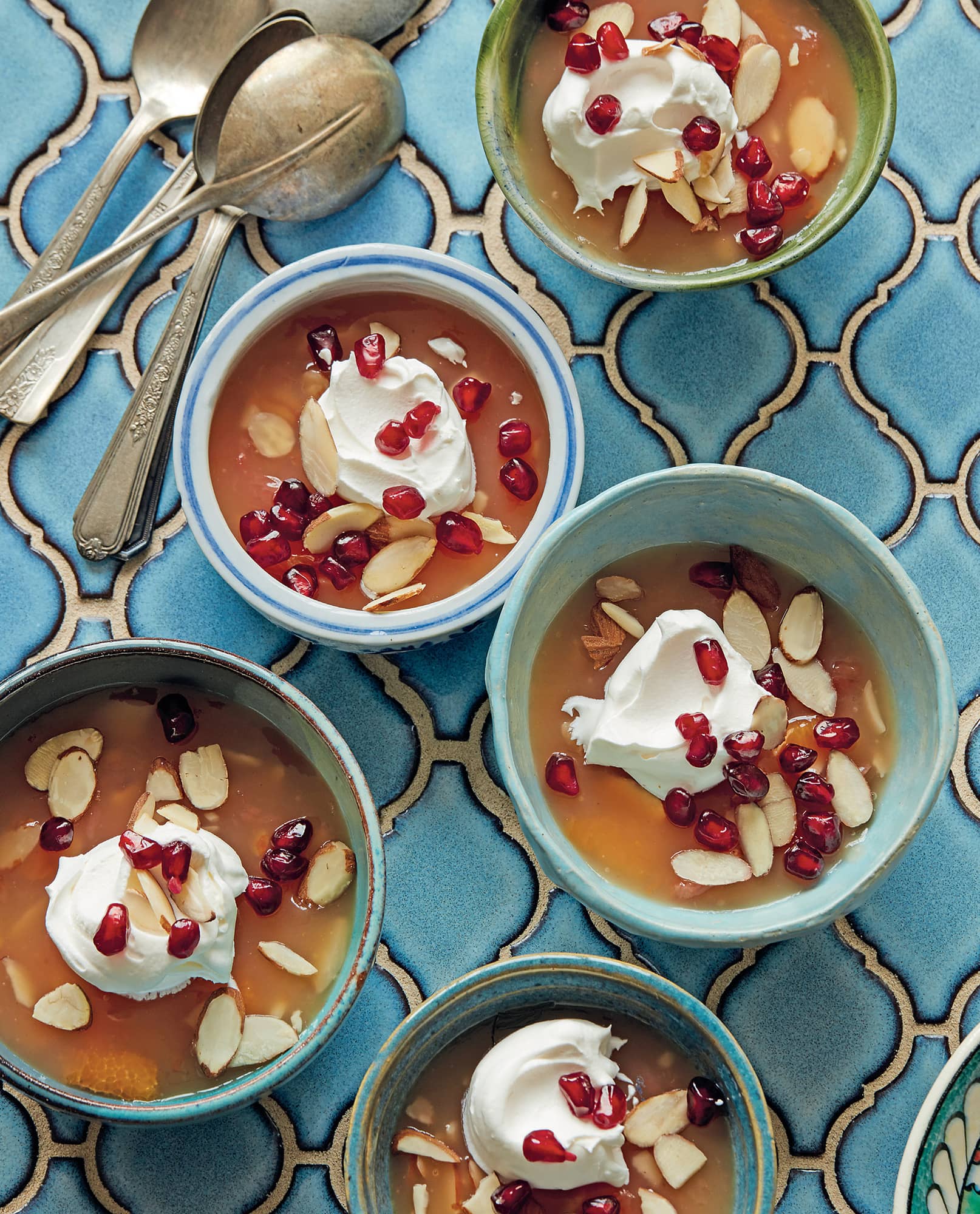
◁ Citrus Pudding with Almonds
SERVES 4 TO 6
Dessert and fruit are often served as separate courses at a Turkish dinner. Inspired by a recipe from an old Ottoman cookbook, we’ve combined them in this light but deeply flavored dessert that highlights tart and sweet citrus as well as fragrant almonds. We’ve modified the original by garnishing with whipped cream and jewel-like pomegranate seeds.
1/4 cup (60 ml) cold water
1/4 cup (30 g) cornstarch
1 grapefruit
1 Valencia or navel orange
1 cup (236 ml) orange juice, strained of pulp
1 cup (236 ml) grapefruit juice, strained of pulp
3/4 cup plus 1 tablespoon (166 g) sugar
3/4 cup (85 g) slivered almonds, 2 tablespoons reserved for garnish
1 cup (240 ml) whipped cream, for serving
1/2 cup (75 g) pomegranate seeds, for serving
In a small bowl, whisk together the water and cornstarch until smooth.
Cut the grapefruit and the orange into supremes (see Note). Cut the supremes into bite-sized pieces and measure out a generous 1/2 cup each of the orange (85 g) and grapefruit (115 g). Set the fruit aside.
Pour the grapefruit and orange juices into a saucepan. Set over medium heat and add the sugar and the cornstarch mixture. Stir continuously until the mixture begins to turn clear and bubbles and thickens.
Add the grapefruit and orange supremes. Cook, stirring gently, for 2 minutes. Remove from the heat. Stir in the almonds and pour into individual serving dishes. Cool to room temperature, then cover and refrigerate for up to 8 hours.
Top with a dollop of sweetened whipped cream before serving. Garnish with the remaining almonds and pomegranate seeds.
Note: To supreme citrus, use a sharp knife to cut off the top and bottom of the fruit. Remove the peel and the pith following the curve of the peel down to the cutting board. To release the segments from their membranes, slide the knife between the segments and their membranes and cut the flesh away. Gently release each segment onto the cutting board. When finished, squeeze any remaining juice from the membranes and discard.

Rosewater Turkish Delight
MAKES ABOUT 70 (1-INCH / 25-MM) SQUARES
Pistachios provide an earthy balance to floral rosewater, while cardamom in the confectioner’s sugar coating adds a subtle warm flavor.
FOR THE SYRUP
2 cups (473 ml) cold water
2 cups (400 g) sugar
1 tablespoon lemon juice
2 tablespoons rosewater
Zest of 1 lemon
1/4 teaspoon kosher salt
FOR THE NOUGAT
1/2 cup plus 2 tablespoons (75 g) cornstarch
1/2 teaspoon cream of tartar
1 cup (236 ml) cold water
1 tablespoon rosewater
2 drops natural red food color (optional)
1 cup (130 g) roasted, unsalted shelled pistachios
FOR THE SUGAR COATING
1 cup (125 g) confectioner’s sugar
1 tablespoon ground cardamom
3/4 cup (96 g) cornstarch
Spray an 8 by 8-inch (20 by 20-cm) square pan lightly with natural nonstick spray and dust it with cornstarch. Alternately, line the pan with parchment and dust the paper with cornstarch.
MAKE THE SYRUP: In a heavy saucepan, combine the cold water, sugar, lemon juice, rosewater, lemon zest and salt. If using a candy thermometer, clip it on the pan. Bring the mixture to a boil over high heat, stirring until the sugar dissolves. Reduce the heat to medium. Simmer for 30 minutes, stirring occasionally, to create a pale yellow syrup. Continue simmering for another 3 to 5 minutes until the surface is covered in bubbles or a candy thermometer reaches 260°F (127°C). Remove from the heat.
MAKE THE NOUGAT: In another heavy saucepan large enough to hold both the nougat and the syrup, combine the cornstarch, cream of tartar, 1 cup (236 ml) cold water and rosewater. Mix until smooth.
Put the saucepan over medium heat, and in a slow, steady stream, pour in the sugar syrup, stirring to combine. Cook for about 15 minutes, stirring constantly to prevent the mixture from sticking to the bottom of the pan, until it thickens and becomes a glossy nougat.
Remove from the heat. Add 2 drops of natural red food color, if desired. Add the pistachios and mix to combine. When the mixture is cool enough to handle, spread the nougat into the prepared pan. With oiled fingers, pat it to create a uniform flat surface about 3/4-inch (19-mm) thick. It’s okay if the nougat doesn’t completely fill the pan. Allow the nougat to set at room temperature for 2 hours, or up to 12 hours.
MAKE THE SUGAR COATING: In a small bowl, combine the confectioner’s sugar, cardamom and cornstarch. Sift the mixture evenly onto a clean, dry work surface or a piece of parchment.
Carefully turn the nougat in a single piece onto the sugar coating. Oil a sharp knife with neutral vegetable oil and cut the nougat into 1-inch (25-mm) cubes. Turn the pieces to liberally coat them in the sugar.
Store the Turkish delight between layers of wax paper and loosely place a paper towel over the nougat before sealing in an airtight container. The paper towel will absorb excess moisture. The nougat will keep in the refrigerator for up to 2 months. Bring to room temperature, and, if necessary, roll again in powdered sugar before serving.


Bountiful display of Turkish Delight (lokum) and other sweets at the Egyptian spice bazaar in Istanbul
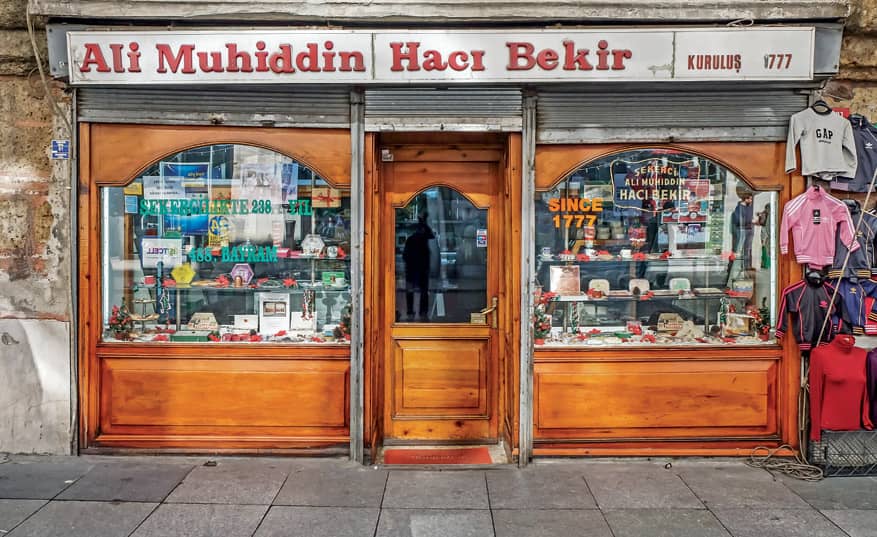
Haci Bekir, Istanbul’s iconic sweet shop and purveyor of Turkish delight since 1777.
Turkish Delight with Mixed Nuts
MAKES ABOUT 70 (1-INCH / 25-MM) SQUARES
Generous handfuls of toasted nuts take the classic citrus-scented nougat to another level. Traditionally, Turkish delight is flavored with rosewater. Our nut-rich version is a sophisticated alternative that’s reminiscent of Italian and Spanish torrone. The nut mixture can be prepared a day or two ahead and stored in an airtight container.
FOR THE NUT MIXTURE
1/2 cup (60 g) walnuts, broken into large pieces
1/2 cup (65 g) unsalted shelled pistachios
1/2 cup (55 g) chopped hazelnuts
FOR THE SYRUP
2 cups (473 ml) cold water
2 cups (440 g) firmly packed light brown sugar
1 tablespoon lemon juice
1 tablespoon orange extract
Grated zest of 1 orange or lemon
1/4 teaspoon kosher salt
2 mint leaves
FOR THE NOUGAT
1/2 cup plus 2 tablespoons (75 g) cornstarch
1/2 teaspoon cream of tartar
1 cup (236 ml) cold water
FOR THE SUGAR COATING
1 cup (125 g) confectioner’s sugar
1 tablespoon ground cardamom
3/4 cup (95 g) cornstarch
Spray an 8 by 8-inch (20 by 20-cm) square pan lightly with natural nonstick spray and dust it with cornstarch. Alternately, line the pan with parchment and dust the paper with cornstarch.
TOAST THE NUTS (shown here): If the hazelnuts still have their skins, let them cool. When cool enough to handle, remove as much of the skin as possible by rubbing the hazelnuts in a clean kitchen towel.
MAKE THE SYRUP: In a medium heavy saucepan, combine the cold water, brown sugar, lemon juice, orange extract, zest, salt and mint leaves. If using a candy thermometer, clip it on the pan. Bring to a boil over high heat, stirring until the sugar dissolves. When the mixture boils, reduce the heat to medium-low and simmer for 30 minutes, stirring occasionally. The syrup should turn a rich dark brown. When bubbles cover the surface or the syrup reaches 260°F (127°C) on a candy thermometer, remove from the heat.
MAKE THE NOUGAT: While syrup simmers, in another heavy saucepan large enough to hold both the nougat and the syrup, combine the cornstarch, cream of tartar and cold water. Place over medium heat, stirring until perfectly smooth. In a slow steady stream, stir in the hot syrup. Cook for about 15 minutes, stirring constantly to prevent the nougat from sticking to the bottom of the pan. The mixture will become thick and glossy.
Scrape the nougat into a mixing bowl. Add the toasted walnuts, pistachios and hazelnuts, stirring until the mixture cools and the nuts are evenly distributed.
Spread the nougat into the prepared pan. With oiled fingers, press the nougat evenly into the pan to create as uniform a surface as possible. Allow the nougat to set at room temperature for at least 12 hours, or a total of 24 hours.
MAKE THE SUGAR COATING: In a small bowl, combine the confectioner’s sugar, cardamom and cornstarch. Sift evenly onto a clean piece of parchment.
Carefully turn the nougat in a single piece onto the sugar coating. Oil a sharp knife with neutral vegetable oil and cut the nougat into 1-inch (25-mm) cubes cubes. Turn the pieces to liberally coat them in the sugar.
Store the Turkish delight between layers of wax paper and loosely place a paper towel over the nougat to absorb excess moisture before sealing in an airtight container. The nougat will keep in the refrigerator for up to 2 months, or in the freezer for 6 months. Bring to room temperature before serving.

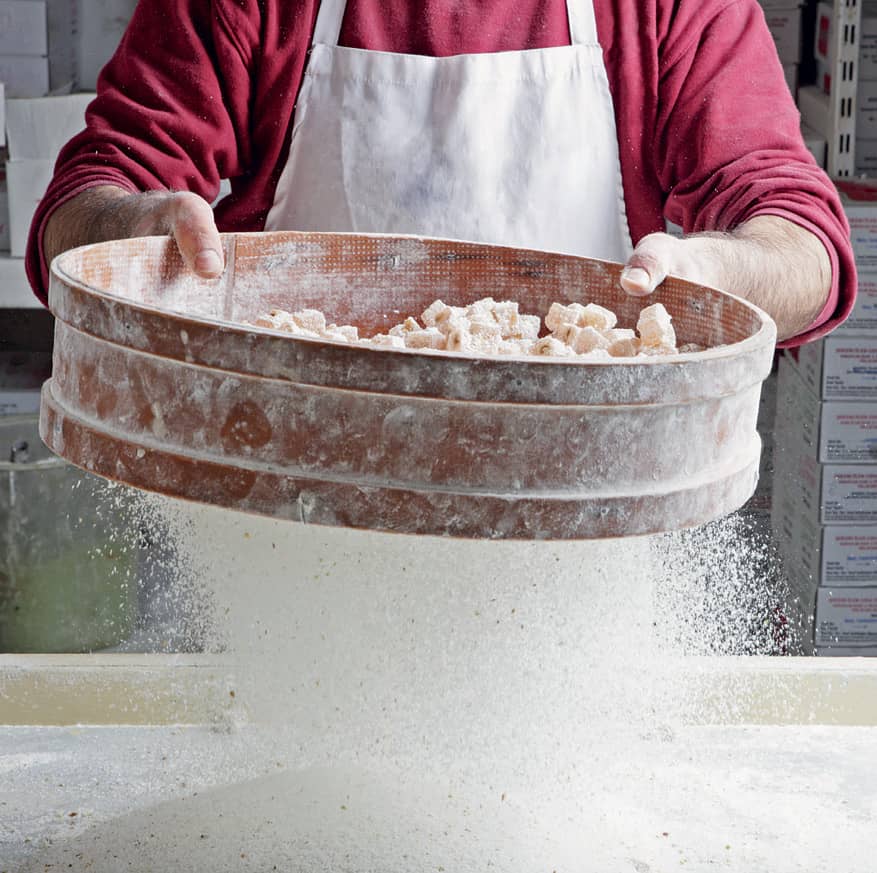
Sifting a fresh batch of Turkish delight with powdered sugar and cornstarch
Orange Yogurt Kahve Cake
MAKES 1 (9-inch/23-cm) CAKE, SERVING 8 TO 10
When our northern and eastern European families left their homelands for new lives working on farms and in factories in the American Midwest, they brought their languages and traditions—and traditional recipes for sour cream coffee cake. As children, we loved the coffee klatches where our mothers, aunts, grandmothers and neighbors gathered to gossip over slices of moist, nutty cake accompanied by cups of coffee poured straight from the percolator. Sometimes, if we were lucky, they’d allow us a cup with a lot of milk.
Kahve means coffee in Turkish. So, with nostalgia and the addition of typically Anatolian yogurt, cardamom and orange, we’ve melded cultures just as immigrants have always done in this easy-to-love cake that’s just made for socializing.
Vegetable oil, for greasing the pan
FOR THE STREUSEL
1/4 cup (55 g) packed brown sugar
1/2 cup (65 g) all-purpose flour
1 teaspoon cinnamon
1/2 teaspoon ground cardamom
1 teaspoon grated orange zest
3 tablespoons butter
3/4 cup (90 g) chopped walnuts
FOR THE CAKE
21/2 cups (315 g) all-purpose flour
2 teaspoons baking powder
1/2 teaspoon baking soda
1/2 teaspoon kosher salt
3/4 cup (170 g / 11/2 sticks) butter, at room temperature
1 cup (200 g) sugar
3 large eggs
1 tablespoon orange juice
11/4 cups (200 ml) Greek yogurt
FOR THE GLAZE
1/2 cup (65 g) confectioner’s sugar
1/2 teaspoon orange extract, or 1 teaspoon pure vanilla extract
1 to 4 teaspoons milk, as needed
Heat the oven to 350°F (175°C). Lightly grease a 9-inch (23-cm) tube or Bundt cake pan with oil, making certain to oil the tube section as well.
MAKE THE STREUSEL: In a small bowl, combine the brown sugar, flour, cinnamon, cardamom and orange zest. Cut the butter into 6 pieces. With a fork or pastry cutter, incorporate the butter into the sugar mixture until the streusel sticks together when pinched with your fingers. Stir in the chopped walnuts and set aside.
MAKE THE CAKE BATTER: In a medium bowl, whisk together the flour, baking powder, baking soda and salt. In a larger mixing bowl, or the bowl of an electric stand mixer, cream the butter until smooth and fluffy, about 3 minutes. Add the sugar and mix for 2 to 3 more minutes, frequently scraping the sides of the bowl. Add the eggs 1 at a time, incorporating each egg before adding the next. Add the flour mixture a little at a time until fully absorbed into the egg mixture. Stir in the orange juice and the yogurt.
Spread a third of the batter evenly over the bottom of the prepared cake pan. Sprinkle half of the streusel mixture over the batter. Repeat with another third of the batter, covering the streusel completely, and sprinkle with remaining streusel mixture. Finish with the remaining batter.
Set the cake on the center rack of the oven. Bake 50 to 60 minutes until a skewer inserted in the cake comes out clean. Set on a rack and let it cool in the pan for at least 30 minutes.
Before removing the cake, use a thin, sharp knife to cut along the outside edge of the cake and the center of the tube. If using an angel food cake pan, pull out the center tube and carefully slide the knife between the cake and the pan to help release the cake. Carefully invert the cake onto a serving plate.
MAKE THE GLAZE: Sift the confectioner’s sugar into a small bowl. Add the orange extract and 1 teaspoon milk. Stir to blend. Continue adding milk, 1 teaspoon at a time, until the glaze becomes a thin, opaque frosting. With a spoon, drizzle the glaze in crisscross ribbons over the cake, letting it stream down the sides.
Serve warm or at room temperature with afternoon tea or Turkish coffee, or as a sweet addition to breakfast or brunch.
